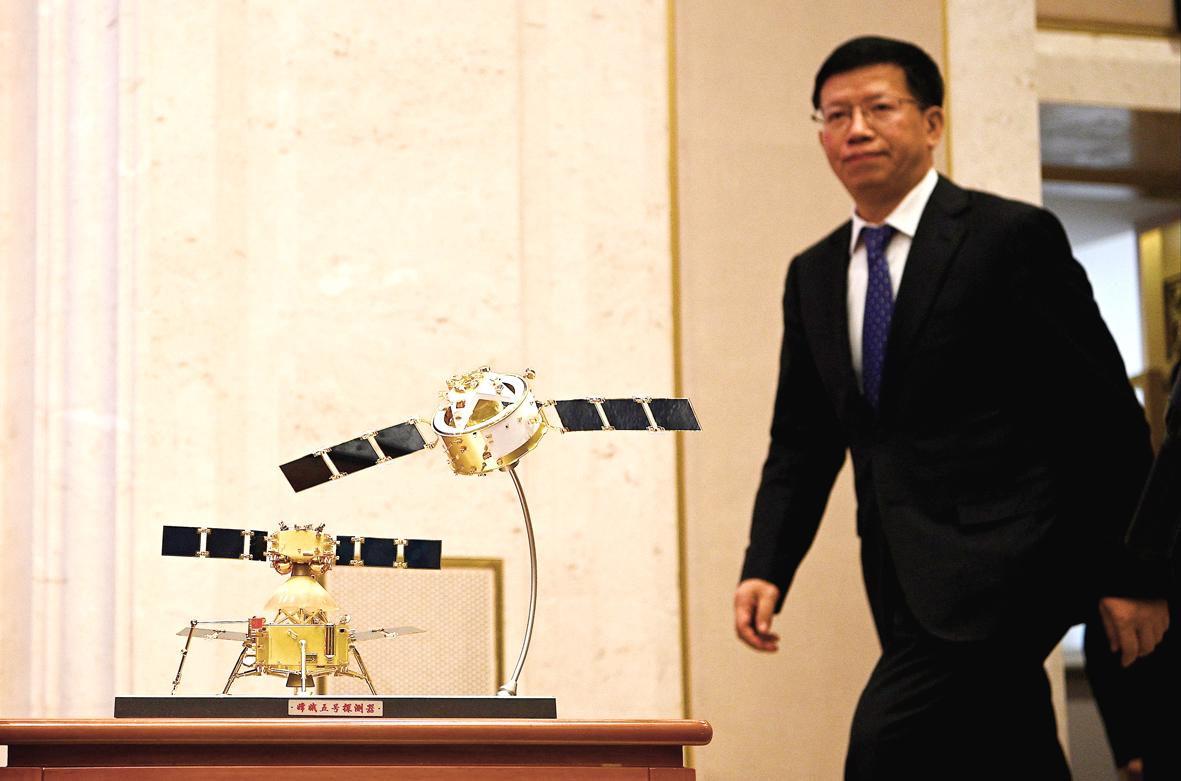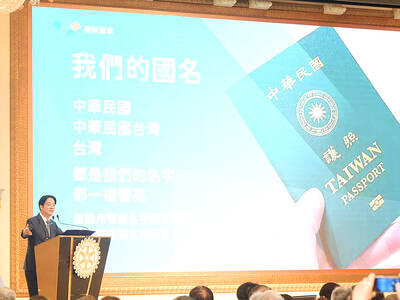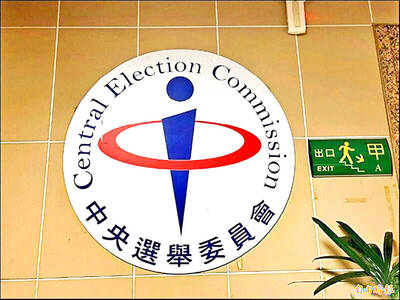Following the successful return of moon rocks by its Chang’e 5 robotic probe, China is preparing for missions that could set the stage for an eventual lunar base to host human explorers, a top space program official said yesterday.
China’s next three lunar missions are on track, along with programs for returning samples from Mars, and exploring asteroids and Jupiter, China Lunar Exploration Program deputy chief commander Wu Yanhua (吳艷華) said.
“Exploring the truth of the universe is just the beginning,” Wu told a news conference held hours after a capsule parachuted to a landing in Inner Mongolia carrying the first lunar samples to be brought to Earth in more than 40 years.

Photo: AFP
The program has made three landings on the moon, including on its less explored far side.
Chang’e 6, scheduled for a 2023 launch, is to collect more samples from the lunar south pole, while the following two are to conduct detailed surveys and test technologies needed for the construction of a science base on the moon.
No dates have been given for Chang’e 7 and 8, or for a crewed mission to the moon that China has said is in the works, or for the construction of a lunar base.
“China is willing to keep on contributing to the world and enhancing human well-being with Chinese space solutions,” Wu said.
The capsule of the Chang’e 5 probe and its cargo of samples were flown to the space program’s Beijing campus after landing just before 2am yesterday.
The mission achieved firsts for China’s lunar exploration program in collecting samples, launching a vehicle from the moon’s surface and docking it with the capsule to transfer the samples for their voyage to Earth, the China National Space Administration (CNSA) said.
“As our nation’s most complex and technically groundbreaking space mission, Chang’e 5 has achieved multiple technical breakthroughs ... and represents a landmark achievement,” it said.
China in 2003 became just the third country to send an astronaut into orbit on its own after the Soviet Union and the US, and its space program has proceeded along a steady, cautious track, largely avoiding the fatalities and launch failures that marred the US-Soviet space race of the 1960s.
Wu said the latest flight featured collaboration with the European Space Agency, along with Argentina, Namibia, Pakistan and other nations with which Chinese cooperates on monitoring and communicating with its spacecraft.
China in the future will “encourage more scientists around the world to participate to obtain more scientific results,” Wu said.
One exception remains the US. Amid concerns over the Chinese space program’s secrecy and close military connections, US law forbids cooperation between NASA and the CNSA unless the US Congress gives its approval.

LONG FLIGHT: The jets would be flown by US pilots, with Taiwanese copilots in the two-seat F-16D variant to help familiarize them with the aircraft, the source said The US is expected to fly 10 Lockheed Martin F-16C/D Block 70/72 jets to Taiwan over the coming months to fulfill a long-awaited order of 66 aircraft, a defense official said yesterday. Word that the first batch of the jets would be delivered soon was welcome news to Taiwan, which has become concerned about delays in the delivery of US arms amid rising military tensions with China. Speaking on condition of anonymity, the official said the initial tranche of the nation’s F-16s are rolling off assembly lines in the US and would be flown under their own power to Taiwan by way

‘OF COURSE A COUNTRY’: The president outlined that Taiwan has all the necessary features of a nation, including citizens, land, government and sovereignty President William Lai (賴清德) discussed the meaning of “nation” during a speech in New Taipei City last night, emphasizing that Taiwan is a country as he condemned China’s misinterpretation of UN Resolution 2758. The speech was the first in a series of 10 that Lai is scheduled to give across Taiwan. It is the responsibility of Taiwanese citizens to stand united to defend their national sovereignty, democracy, liberty, way of life and the future of the next generation, Lai said. This is the most important legacy the people of this era could pass on to future generations, he said. Lai went on to discuss

MISSION: The Indo-Pacific region is ‘the priority theater,’ where the task of deterrence extends across the entire region, including Taiwan, the US Pacific Fleet commander said The US Navy’s “mission of deterrence” in the Indo-Pacific theater applies to Taiwan, Pacific Fleet Commander Admiral Stephen Koehler told the South China Sea Conference on Tuesday. The conference, organized by the Center for Strategic and International Studies (CSIS), is an international platform for senior officials and experts from countries with security interests in the region. “The Pacific Fleet’s mission is to deter aggression across the Western Pacific, together with our allies and partners, and to prevail in combat if necessary, Koehler said in the event’s keynote speech. “That mission of deterrence applies regionwide — including the South China Sea and Taiwan,” he

UNPRECEDENTED: In addition to the approved recall motions, cases such as Ma Wen-chun’s in Nantou are still under review, while others lack enough signatures The Central Election Commission (CEC) announced yesterday that a recall vote would take place on July 26, after it approved the first batch of recall motions targeting 24 Chinese Nationalist Party (KMT) lawmakers and Hsinchu Mayor Ann Kao (高虹安). Taiwan is in the midst of an unprecedented wave of mass recall campaigns, following a civil society push that echoed a call made by Democratic Progressive Party (DPP) caucus whip Ker Chien-ming (柯建銘) in January to initiate signature drives aimed at unseating KMT legislators. Under the Civil Servants Election and Recall Act (公職人員選舉罷免法), Taiwanese can initiate a recall of district-elected lawmakers by collecting